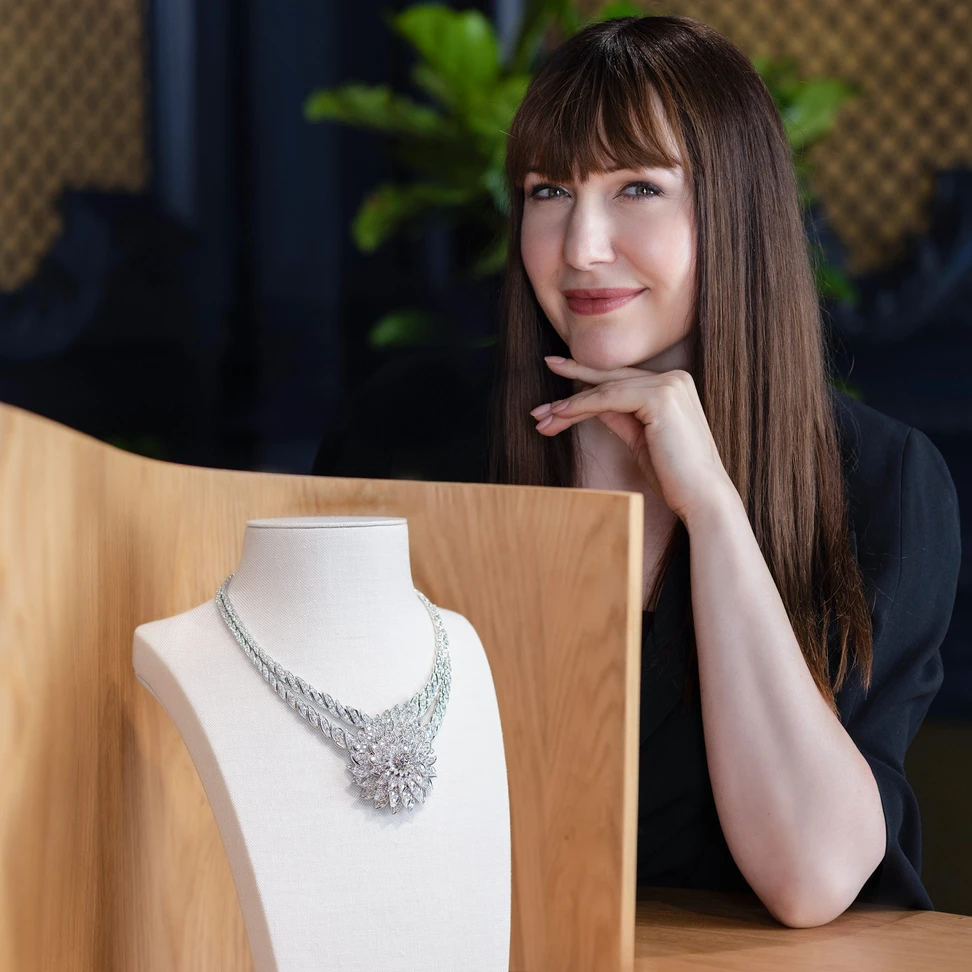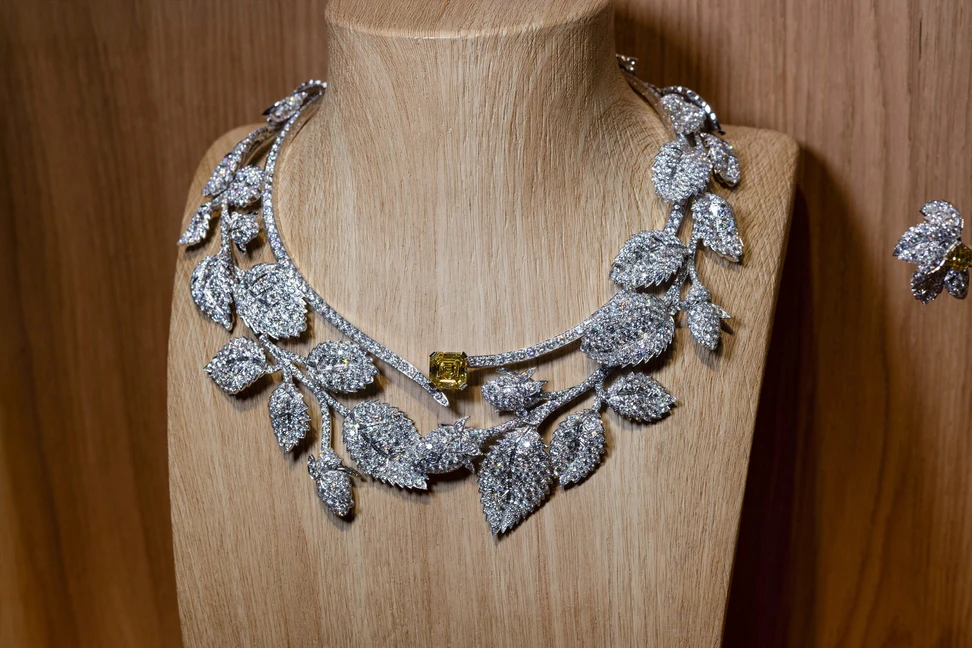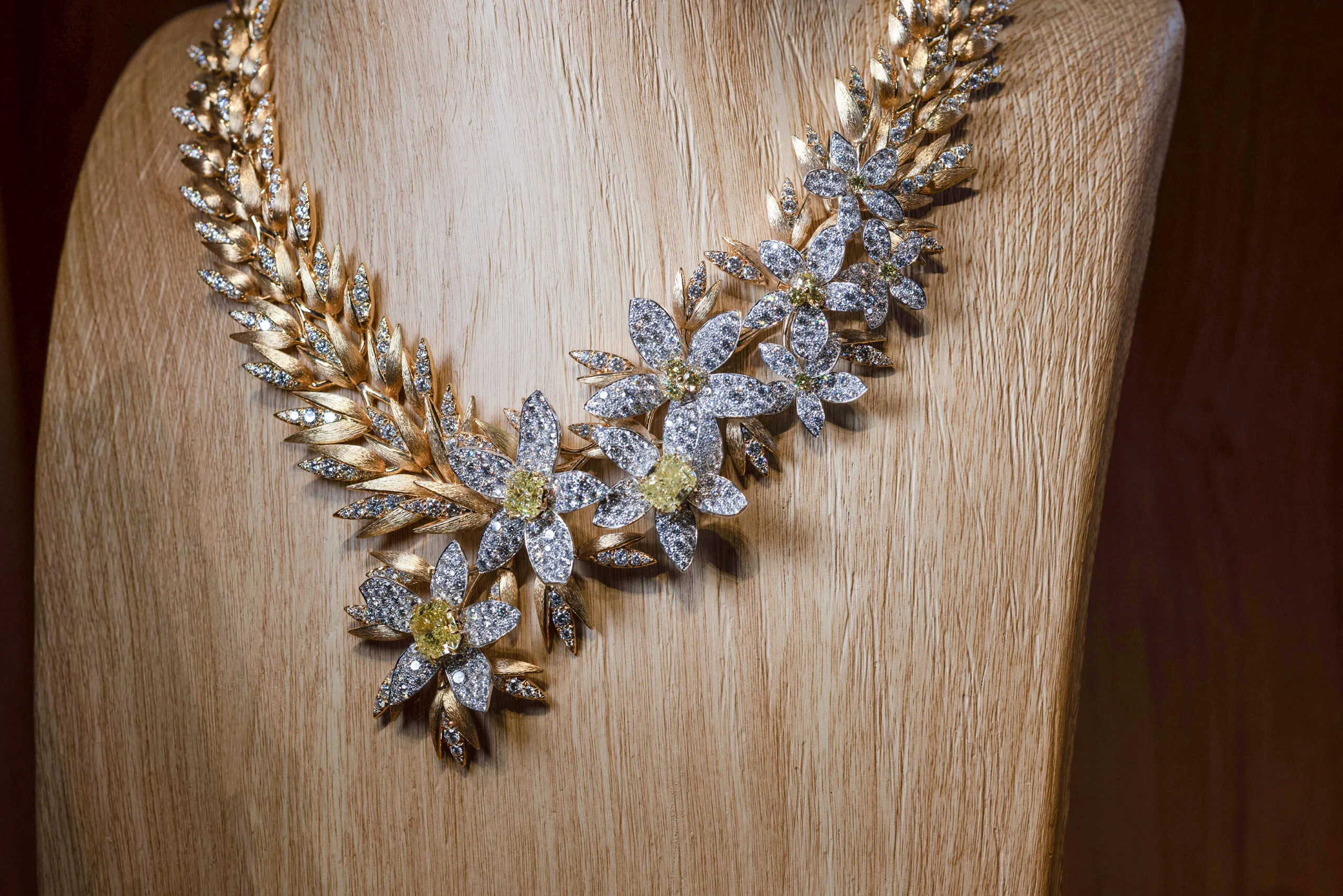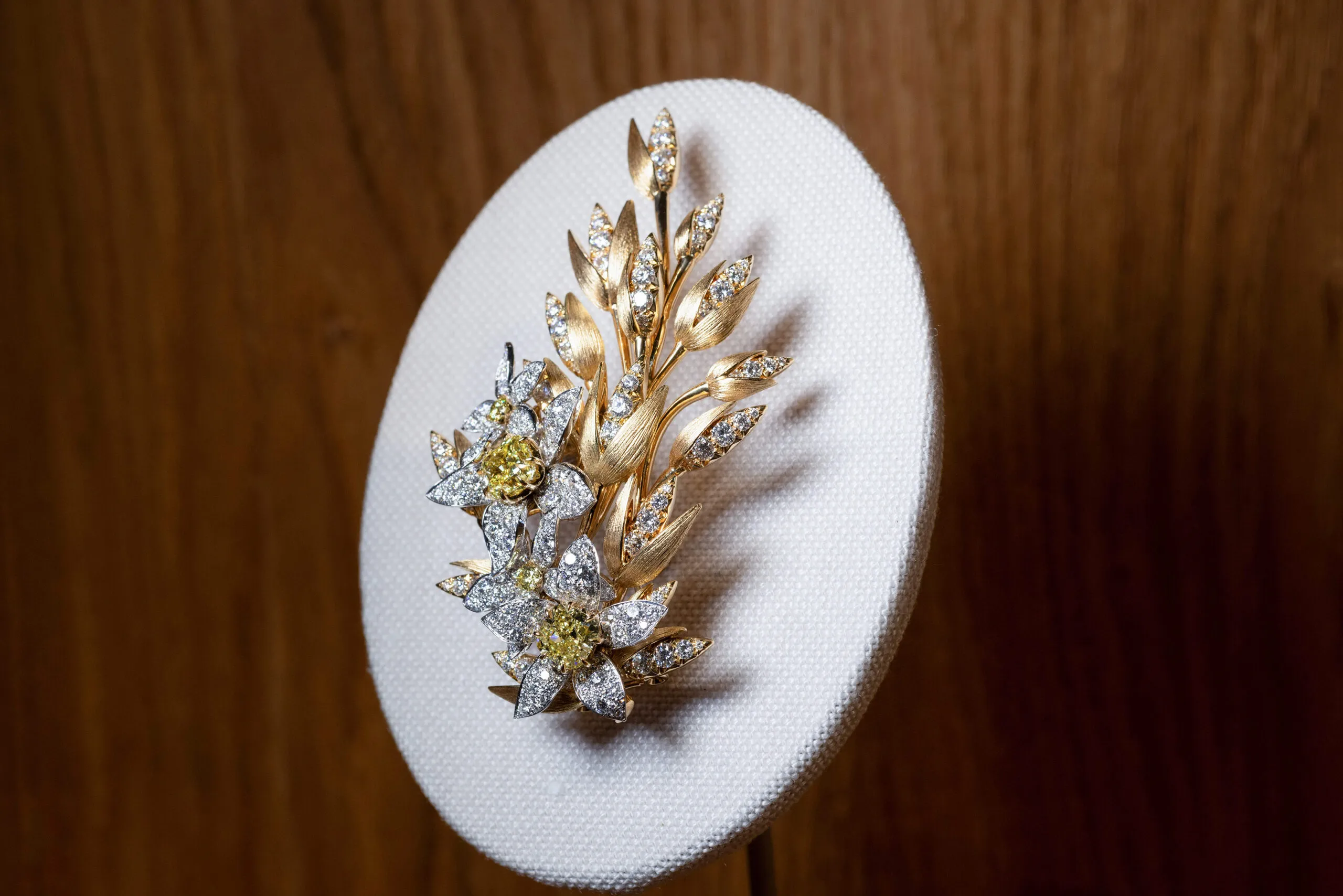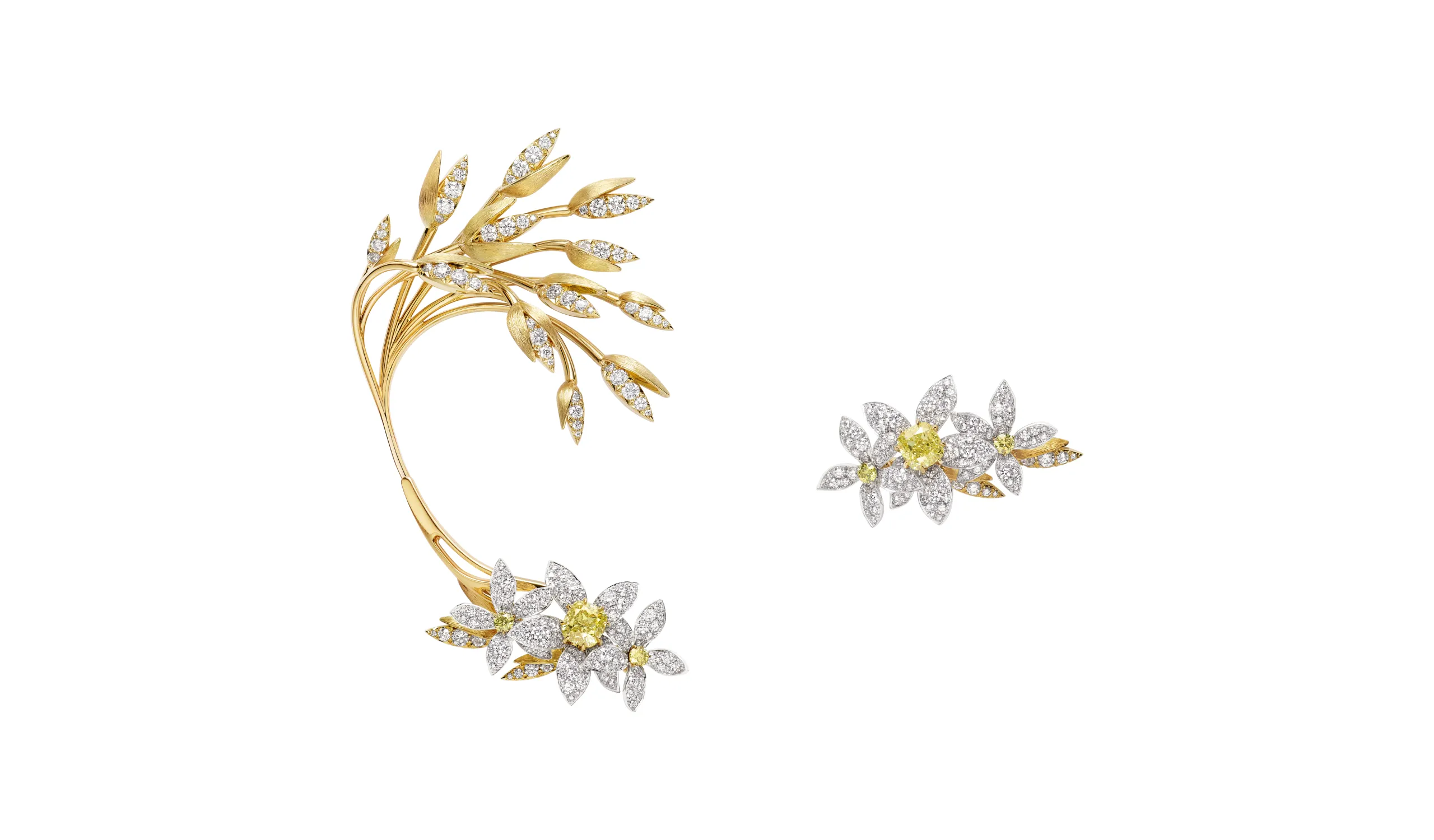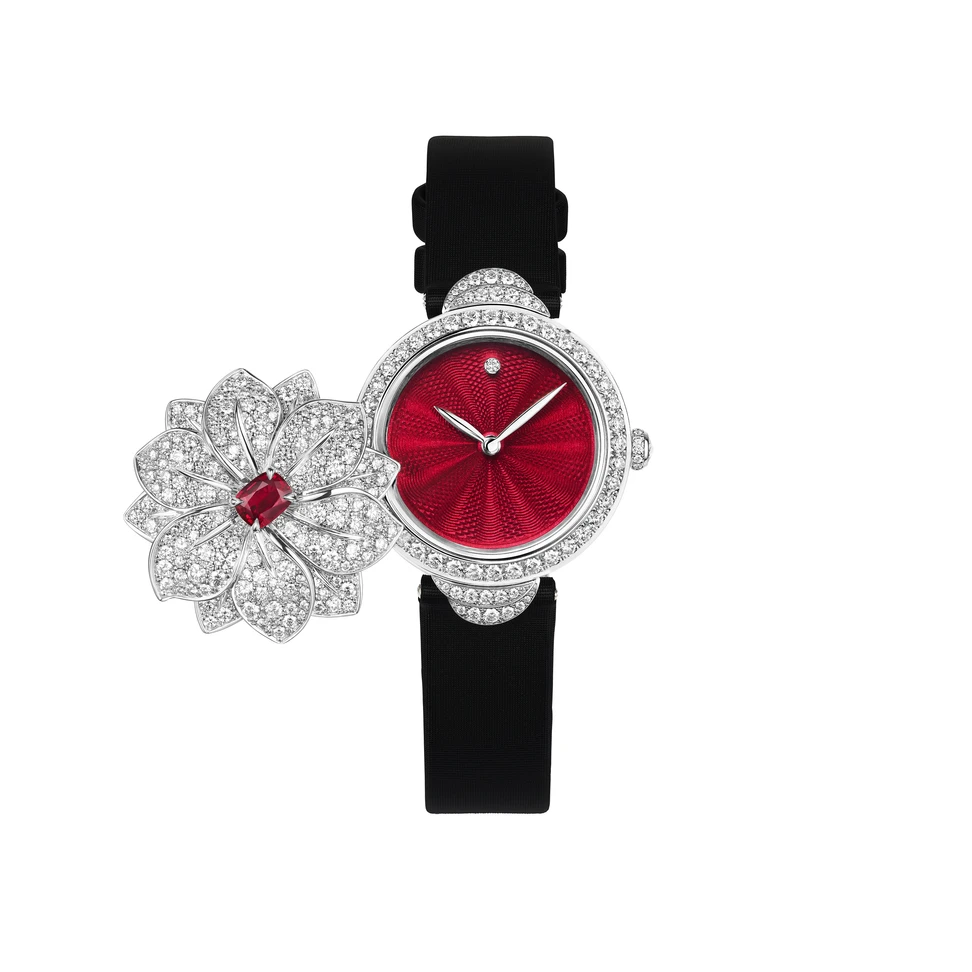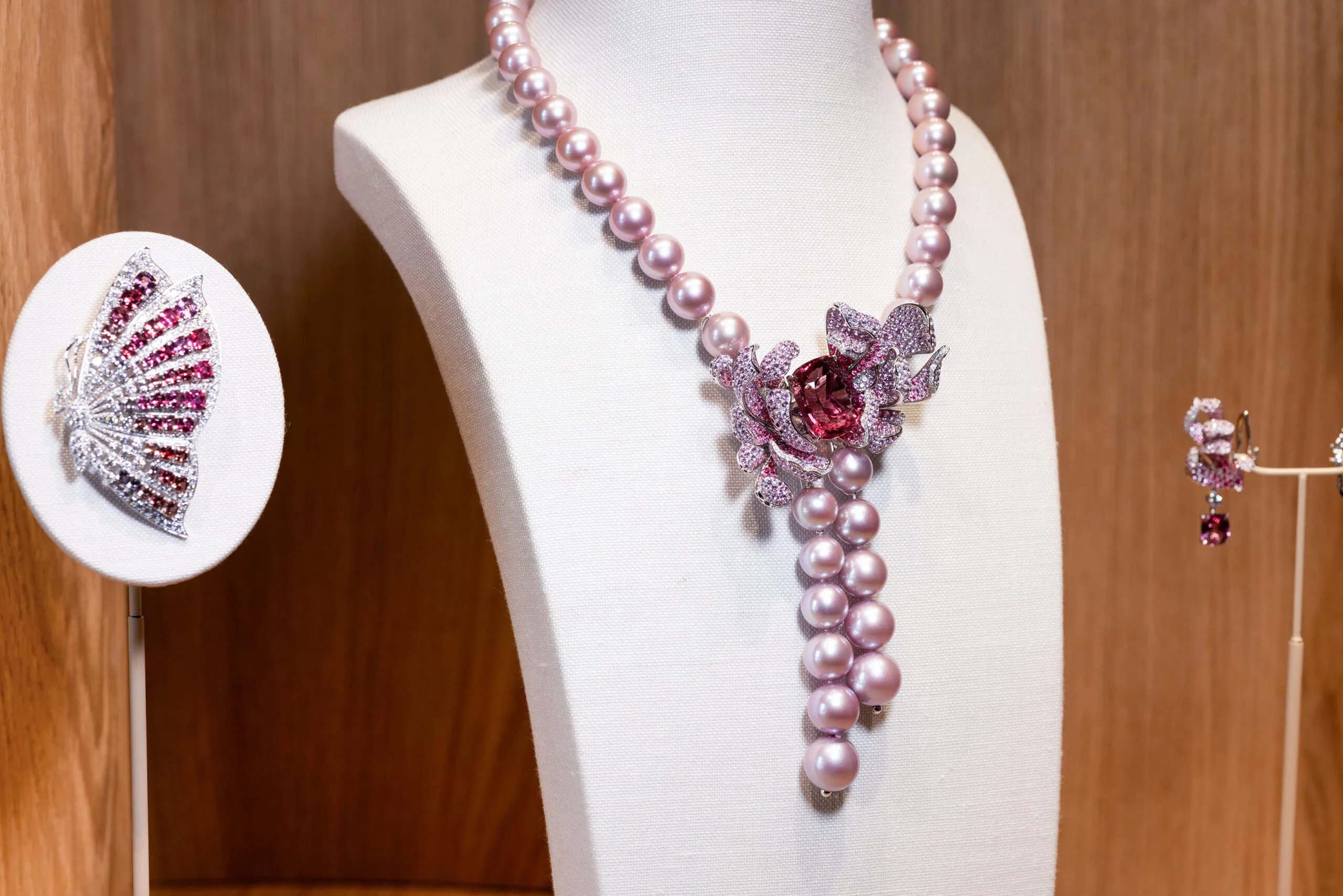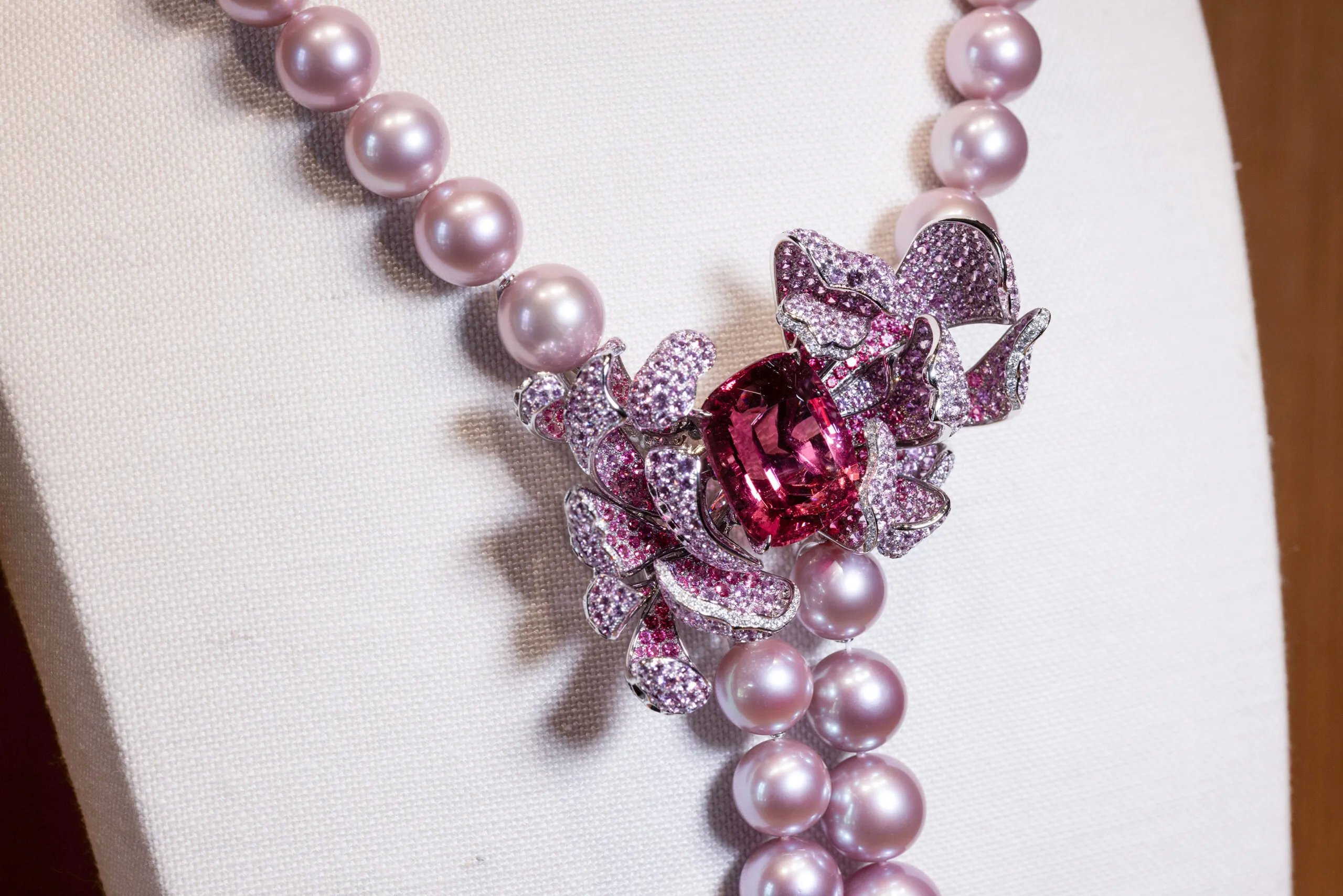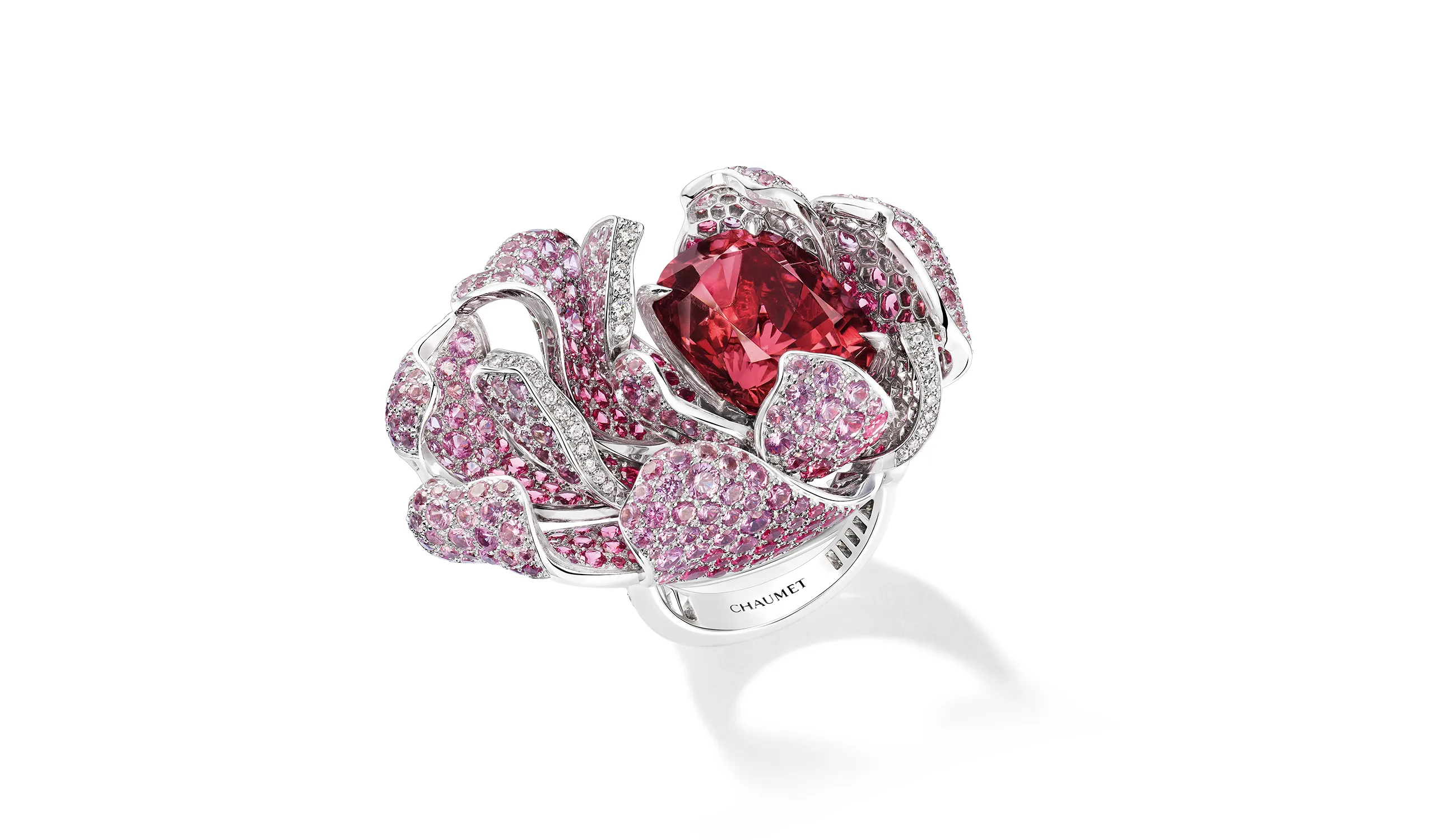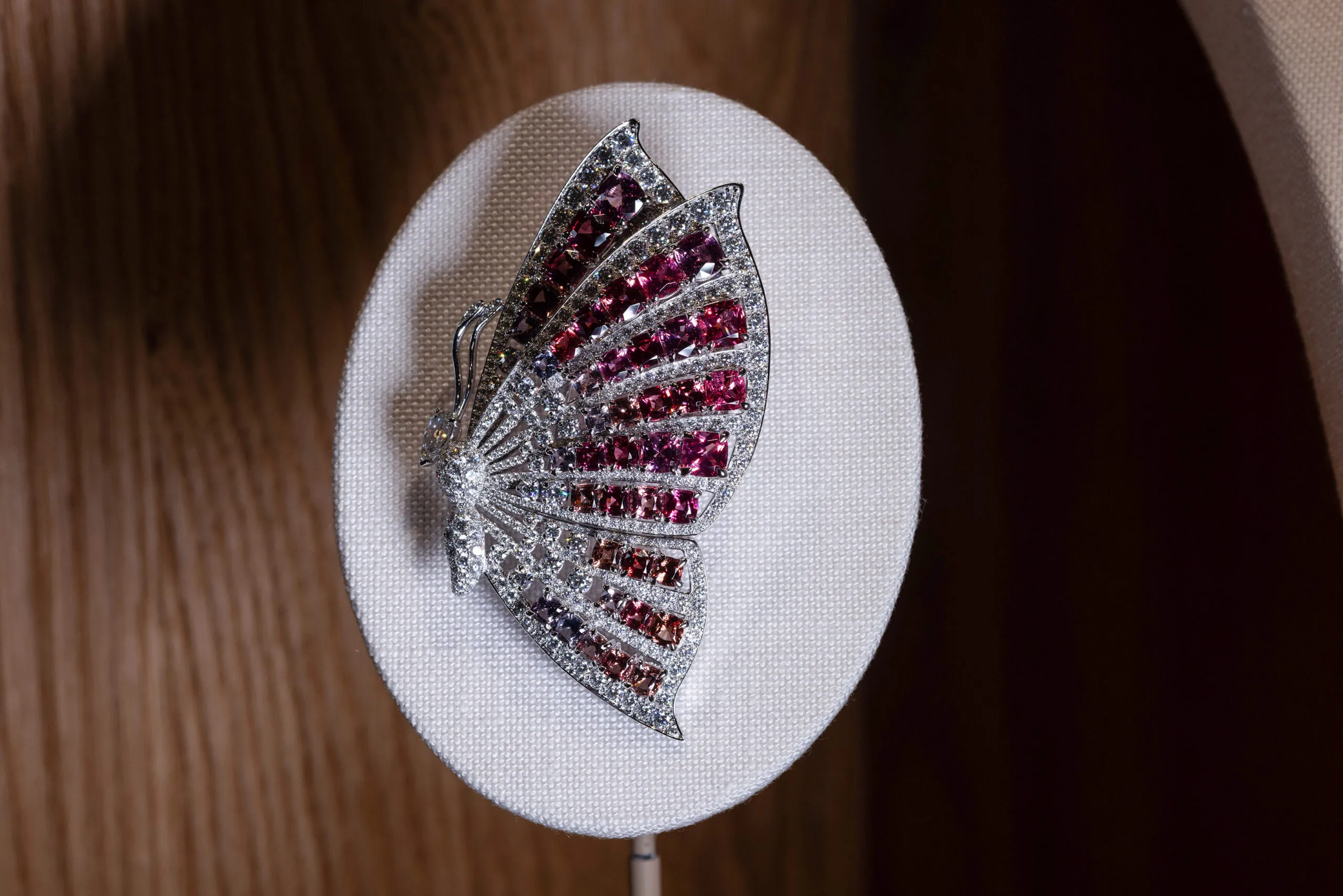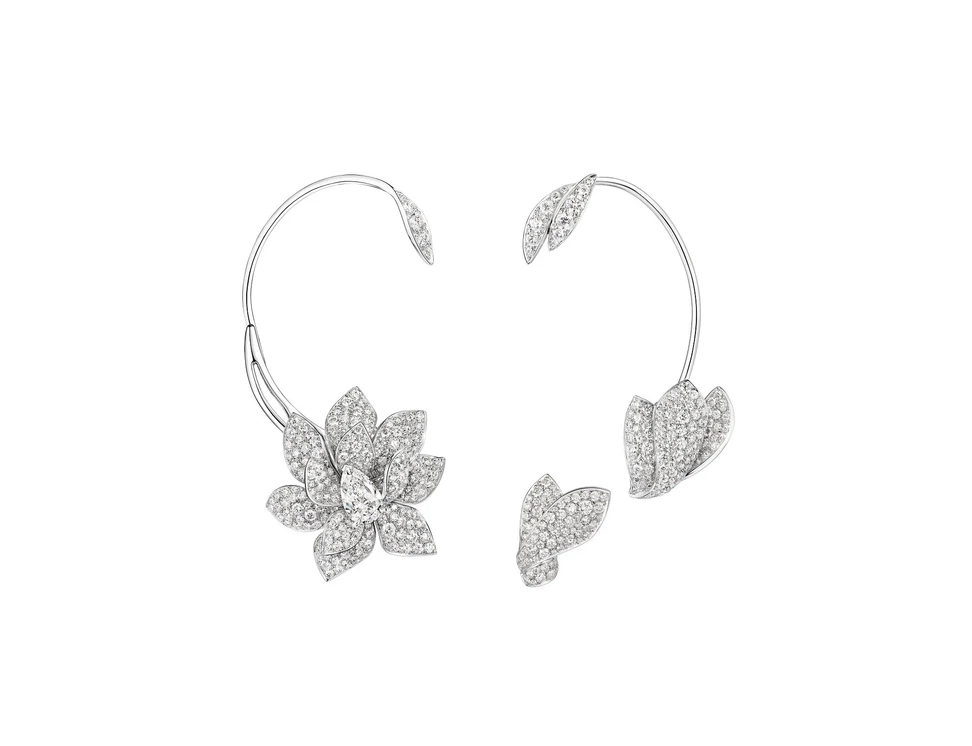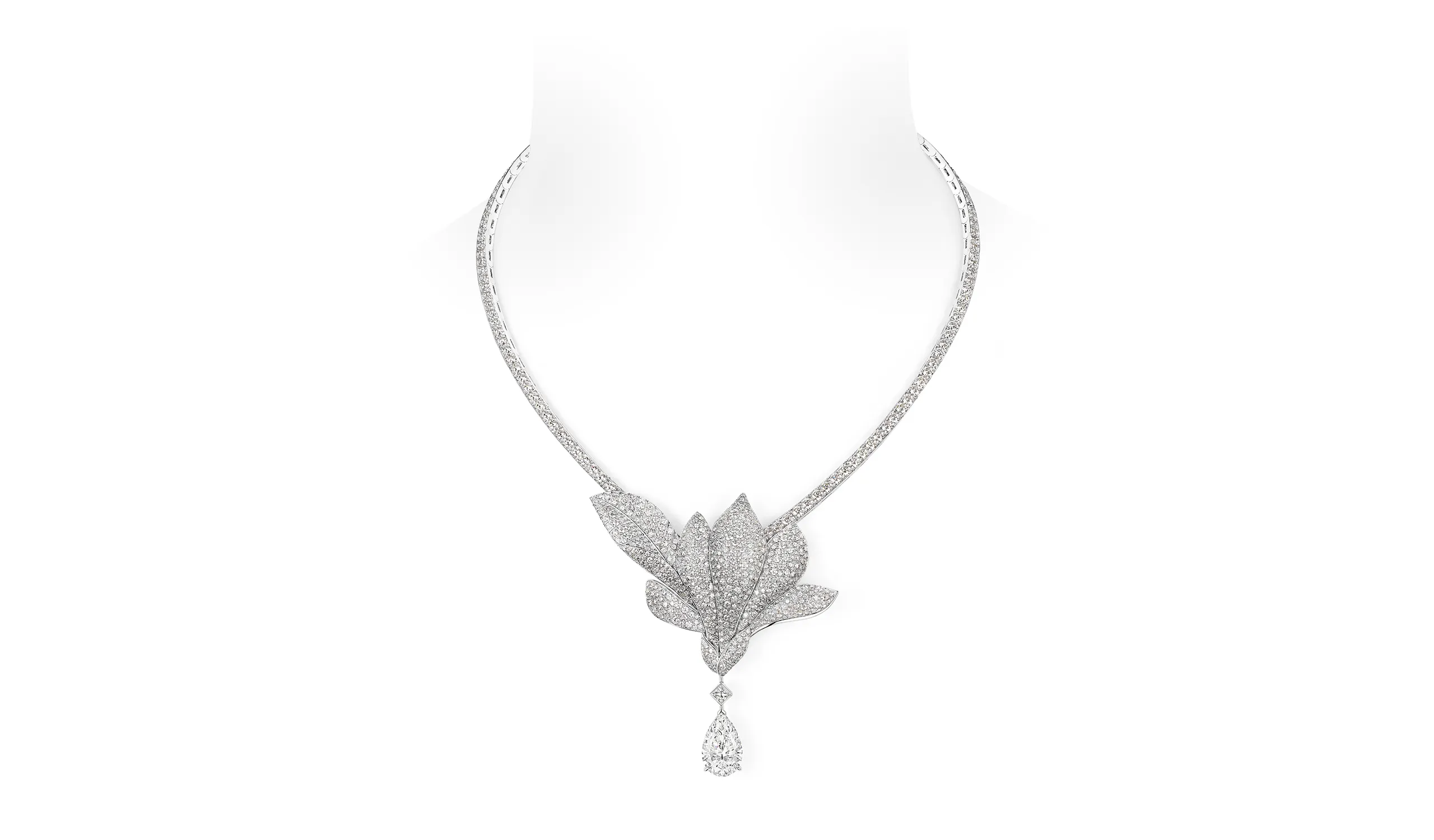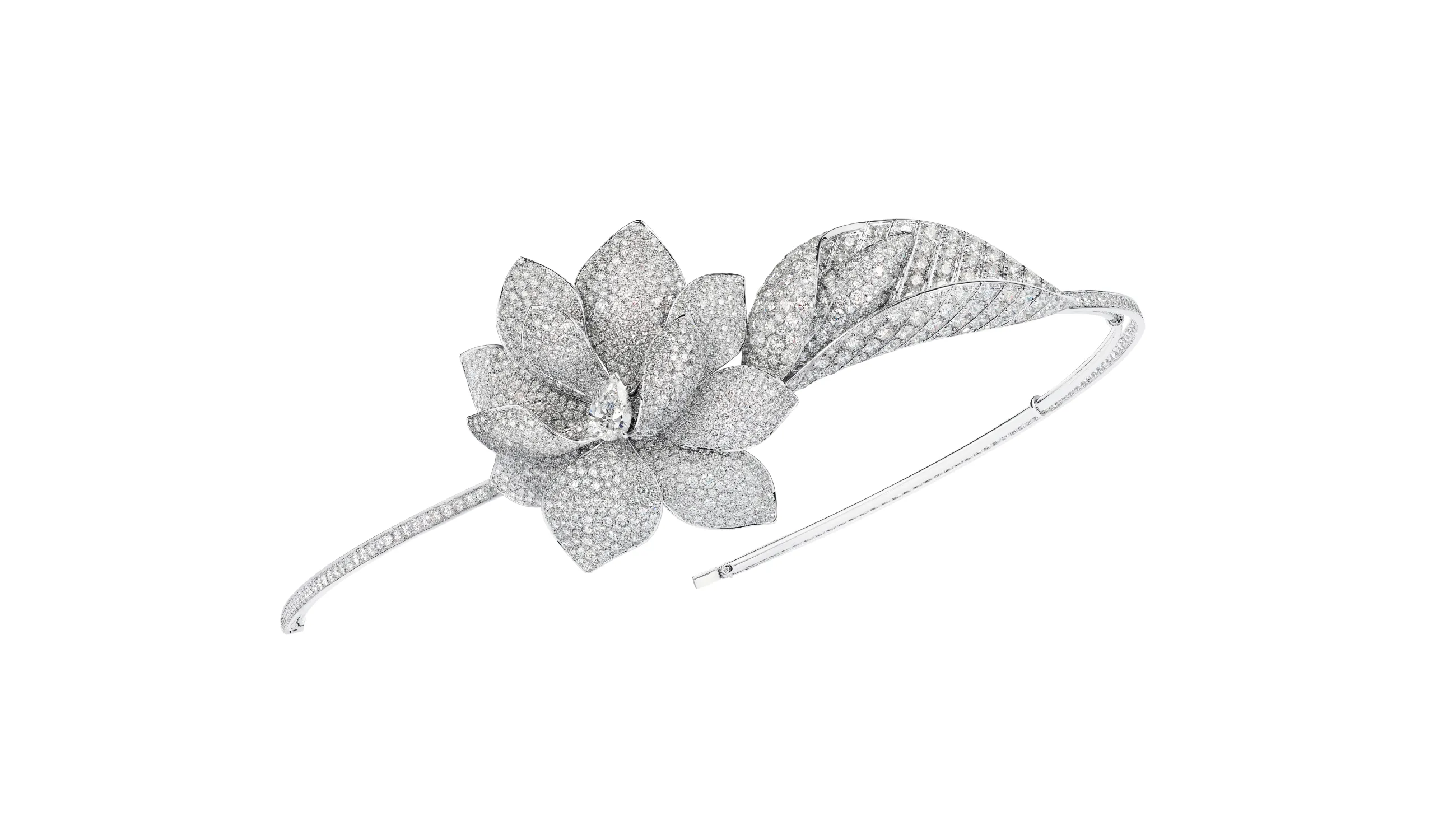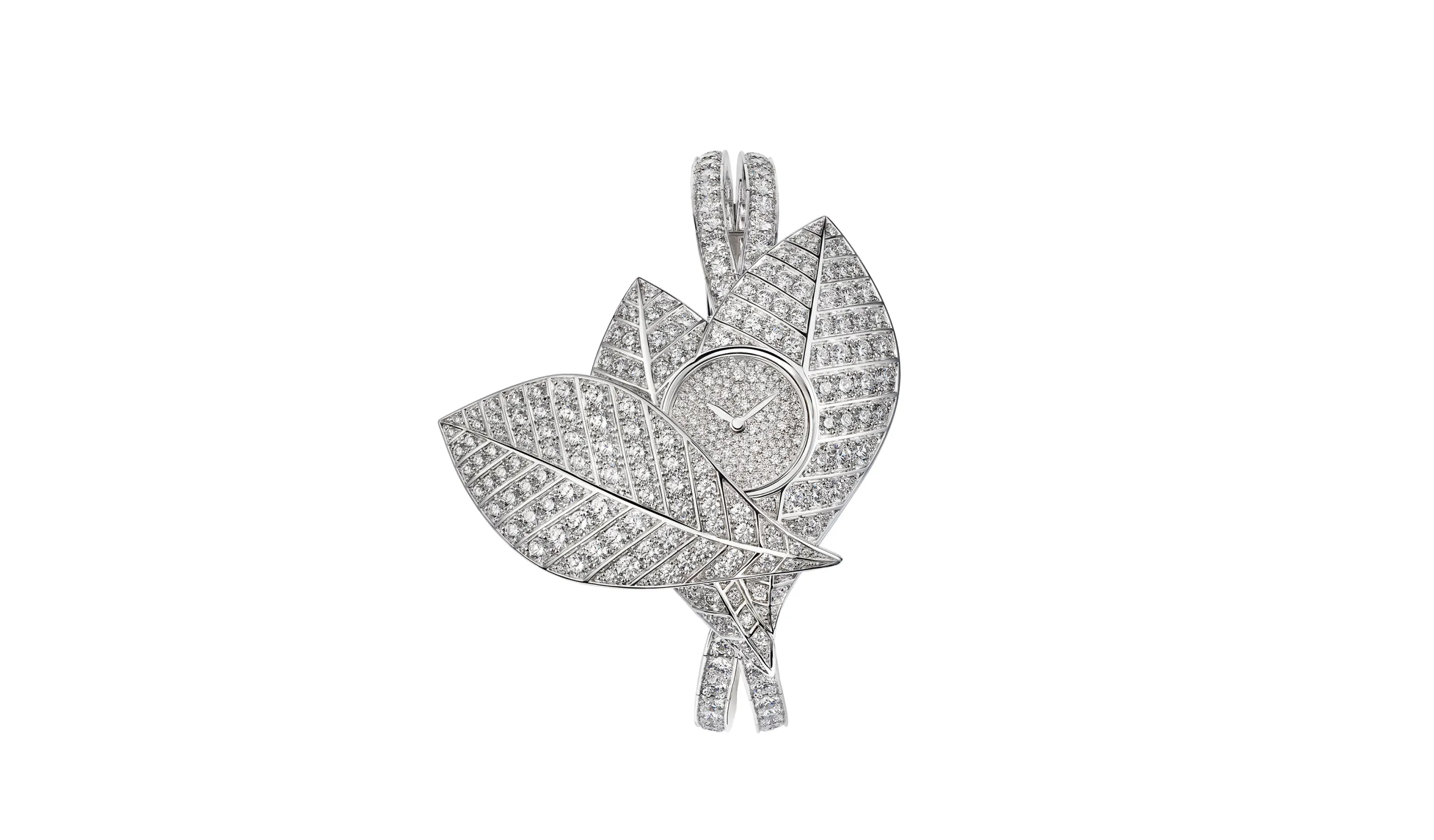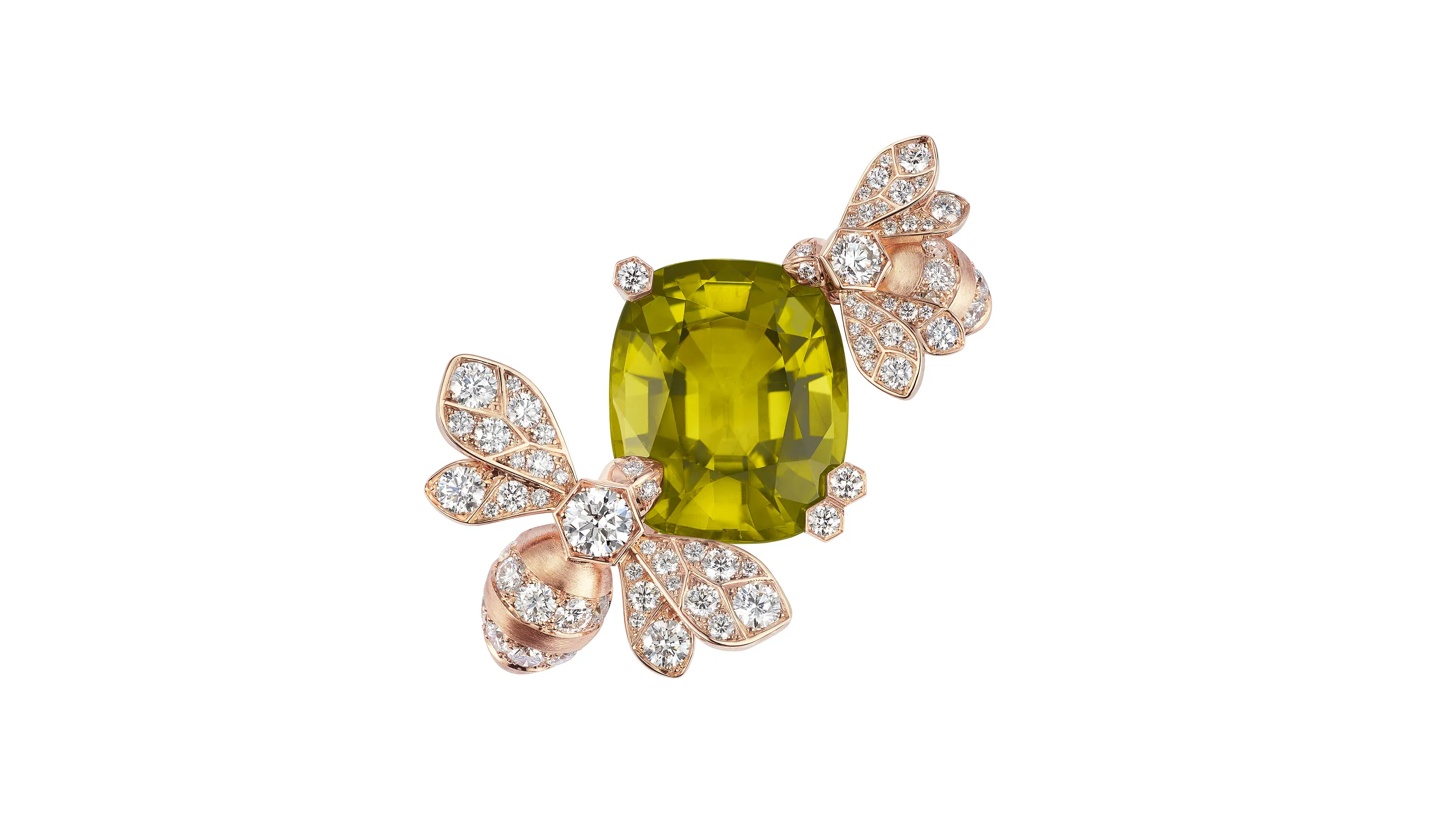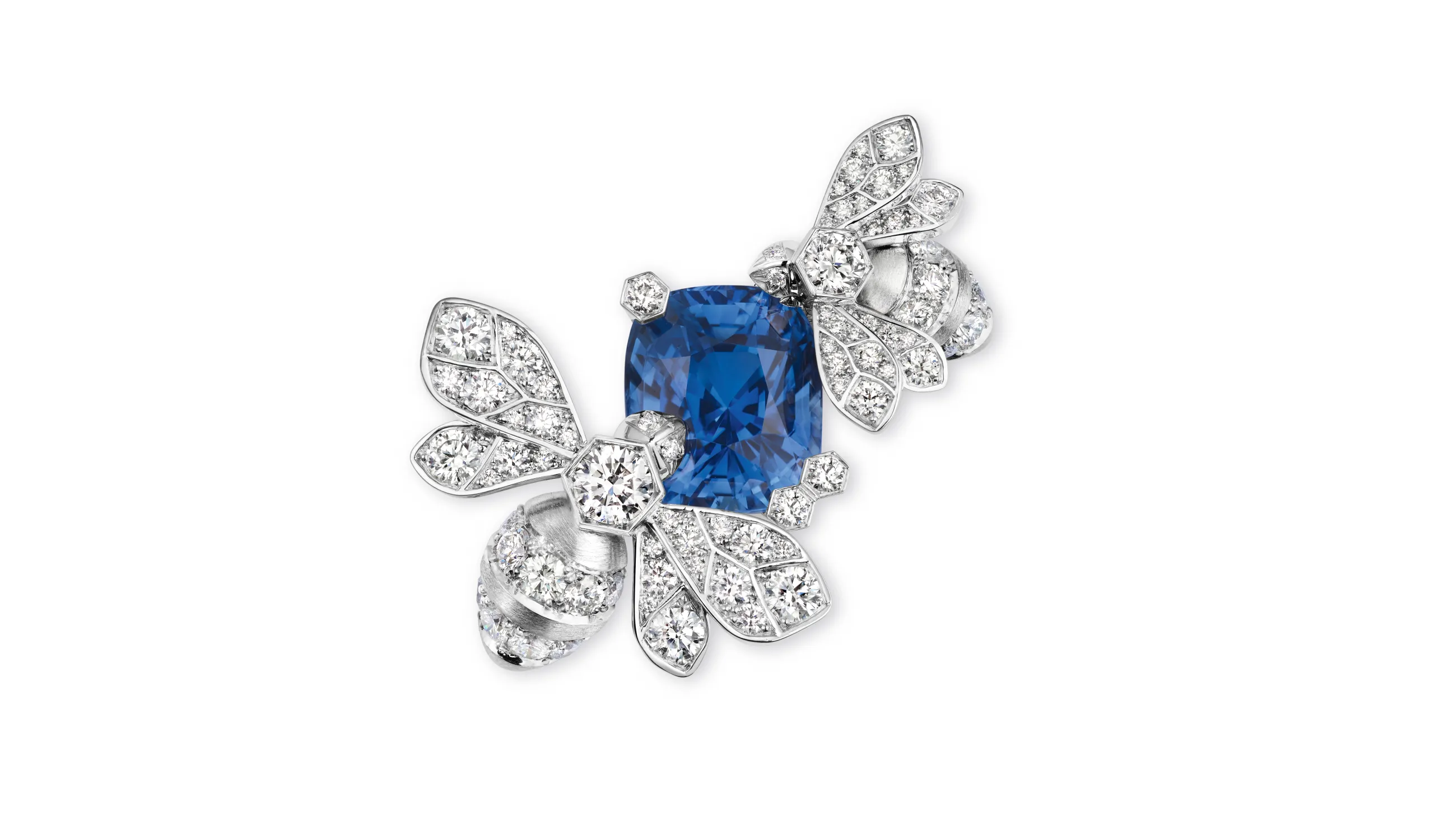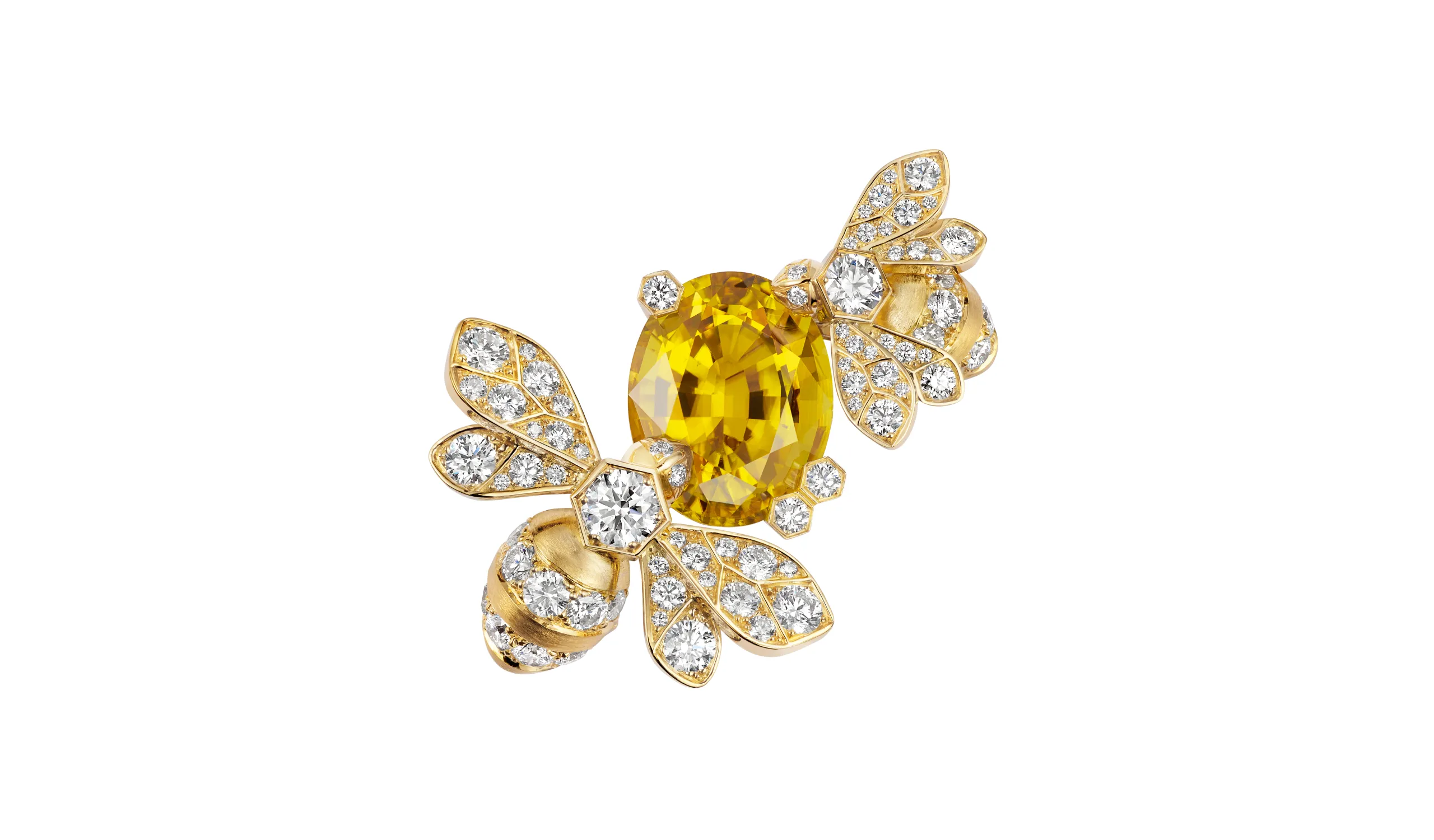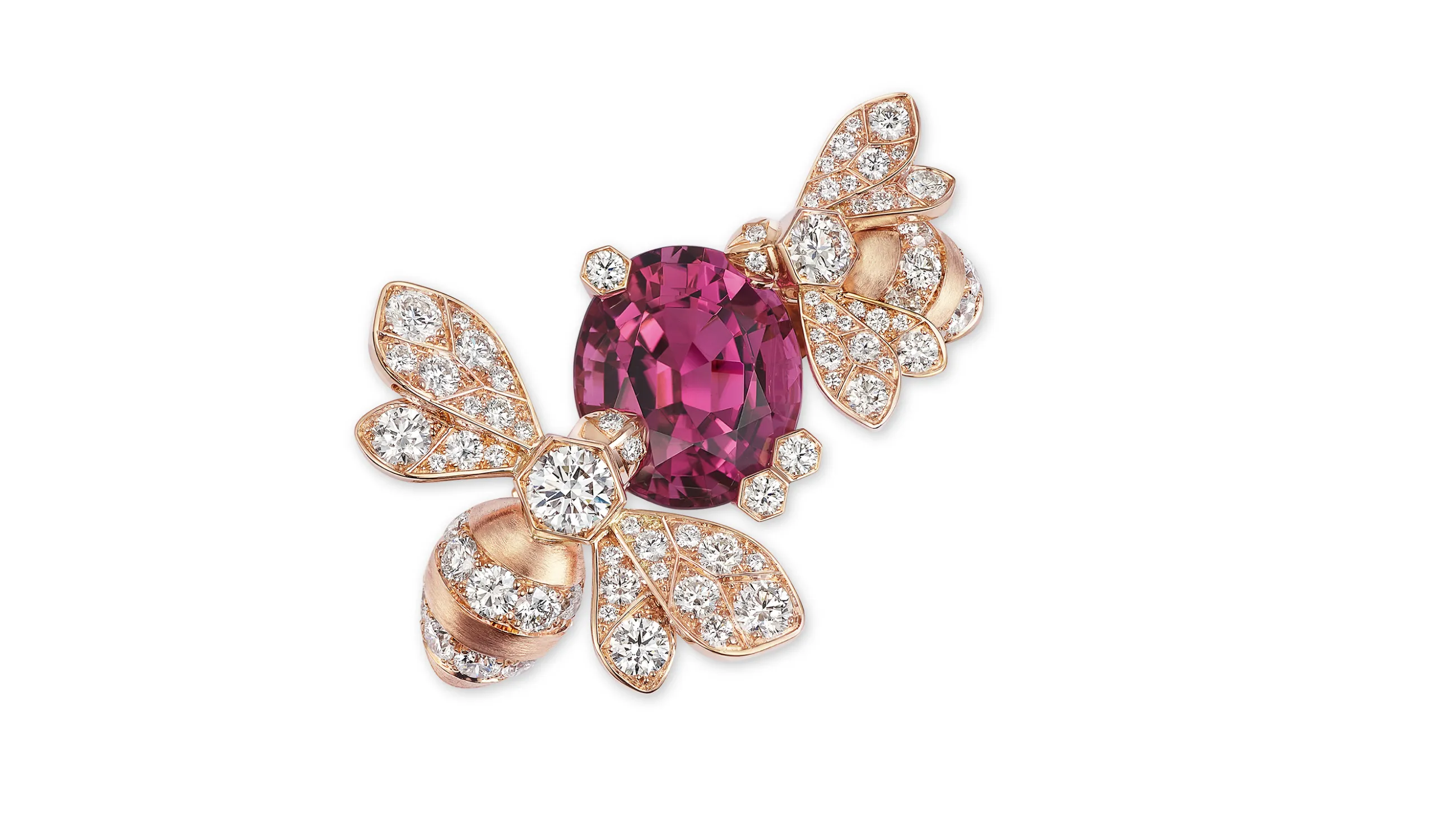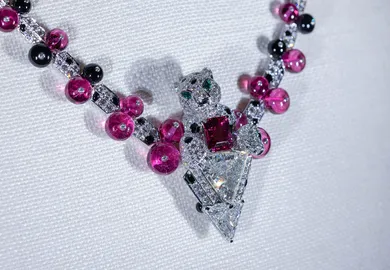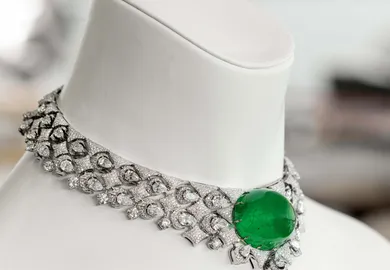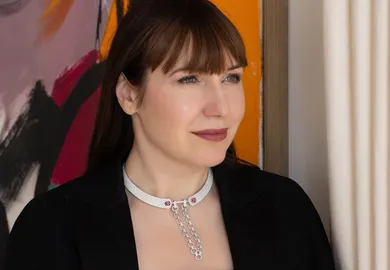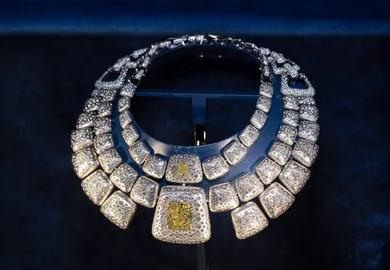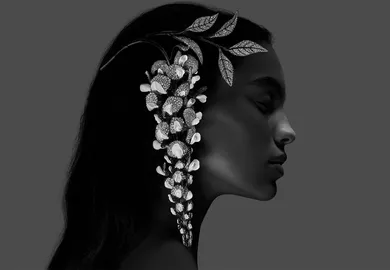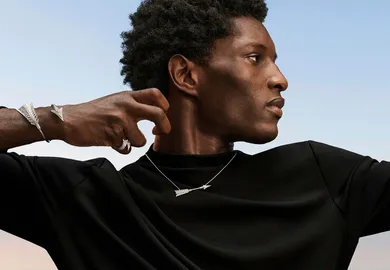
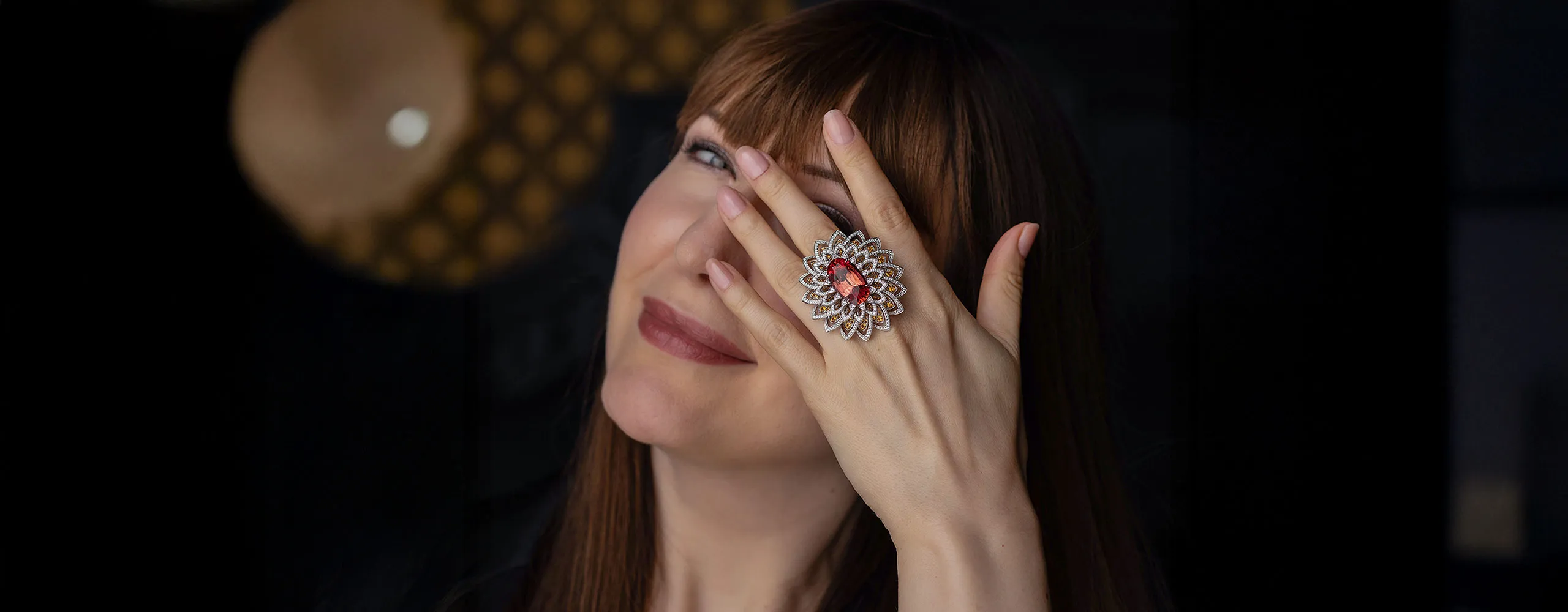
Haute Couture 2025: A Botanical Reawakening with the Chaumet Jewels by Nature Collection
From magnolia blooms to iris petals caught in the breeze, Chaumet’s Jewels by Nature is a high jewellery collection rooted in the way Empress Joséphine romanticised the natural world. At Château de Malmaison — her private residence — she cultivated a living museum of rare and exotic plants. With heated greenhouses and roaming birds, it was there that her passion for horticulture took hold, and where nature became a lifelong obsession.
As the Maison de Chaumet’s first great muse, Joséphine’s love of flora helped define the early visual language of the Parisian jeweller who made many of her jewels. More than two centuries later, that connection continues to bloom. In Jewels by Nature, Chaumet returns to the plants and pollinators that once flourished in the Empress’s garden.
Katerina with the Dahlia high jewellery necklace from Jewels by Nature, Chaumet’s latest high jewellery collection
Chapter 1: Everlasting
In the first chapter of Jewels by Nature, Chaumet draws inspiration from wild flora—roses, clovers, ferns—and the field star flowers that grow in oat fields. The strength and elegance of these hardy perennials are captured in parures that combine intricate botanical forms with a bold design language.
The chapter begins with the Wild Rose suite and its tangle of leaves and rosebuds. Chaumet recreates the serrated edges and sculptural curves of a wild rose’s leaves with absolute fidelity. Honouring the Wild Rose Leaf tiara, created by Joseph Chaumet in 1922, the transformable necklace can be worn in three different ways, its diamond leaves and rosebuds scattered gracefully across the collarbone, culminating in an 8.23 carat square emerald-cut fancy vivid yellow diamond.
Inspired by an archival tiara, the Wild Rose white and yellow diamond high jewellery necklace can be worn in three different ways
Gold ripples like wind through a summer field in the Oat and Field Star necklace. Unlike compact ears of wheat, Chaumet’s oat stems end in branching clusters of grains, each one articulated to capture the gentle sway of crops stirred by the breeze. Opposite, white diamond field stars are arranged in a garland, their centres radiating with cushion-cut yellow diamonds.
This sense of movement continues in the Oat and Field Star earrings. One ear is crowned with a cuff, with diamond field stars tracing the curve of the lobe and a removable golden spray of oat stems arcing above. On the other, an ear climber blooms across the lobe in a cluster of white and yellow diamonds. Together, they speak to the wild abundance of nature.
The Clover and Fern high jewellery necklace centres on a cherished Chaumet emblem. Heart-shaped clover leaves bloom across one half of the neckline, some glowing with pear-shaped Colombian emeralds, others pavé set with diamonds and edged in emeralds, while on the opposite side, diamond fronds evoke the feathery leaves of ferns. The matching earrings mirror this interplay of structure and softness. Each ear is adorned with an emerald and diamond four-leaf clover, from which cascades a spray of articulated diamonds, as delicate and light-catching as a newly unfurled fern frond.
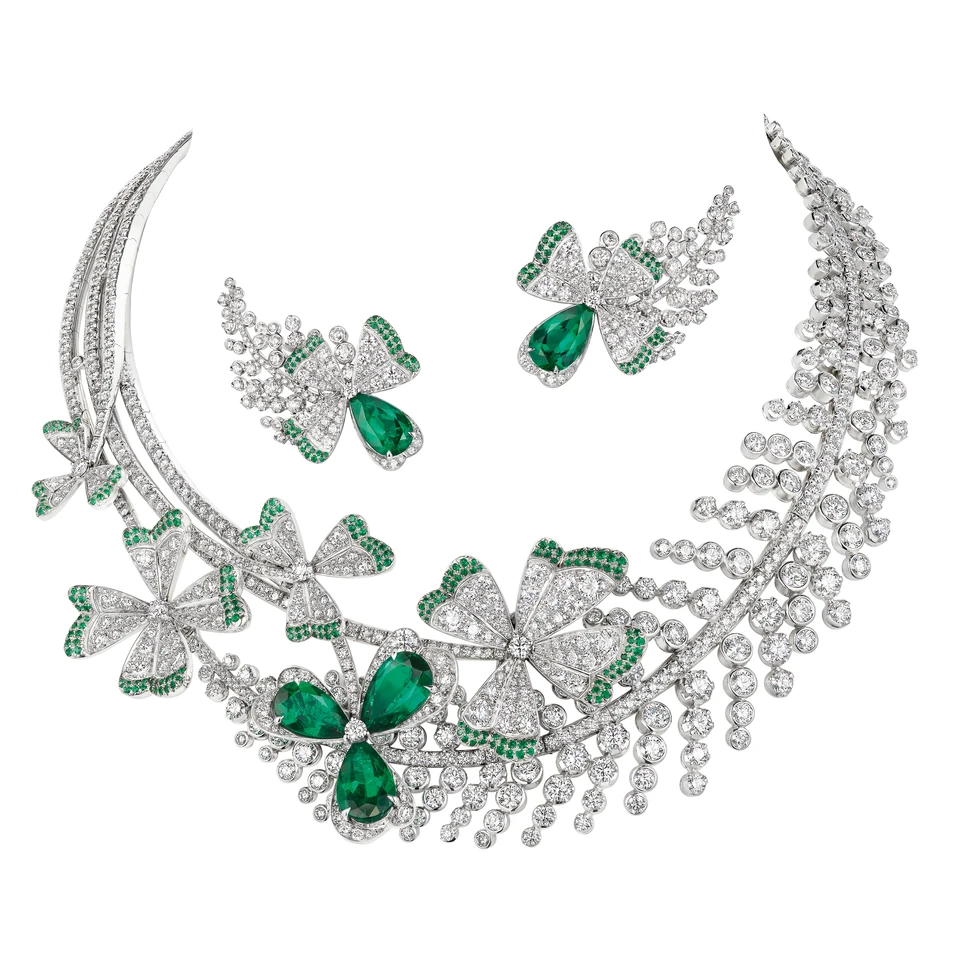
The Clover and Fern emerald and diamond high jewellery necklace and earrings reflect the naturalism embedded in Chaumet’s history
Chapter 2: Awakening
The second chapter of Jewels by Nature pays tribute to the vanishing wonders of the floral kingdom — blossoms whose beauty lasts only a moment but lingers in the memory. Carnations, sweetshrubs and sword-lilies, and their short-lived blooms, inspire parures that capture nature at its most fleeting.
Stylising a famously ruffled bloom, six diamond-set flowers blossom in radiant asymmetry on the Carnation necklace. Beneath the frilled petals, stems of invisibly set sapphires transition from deep to sky blue — a signature Chaumet hue that unites the suite — with a detachable 36.44 carat Ceylon sapphire adding intensity.
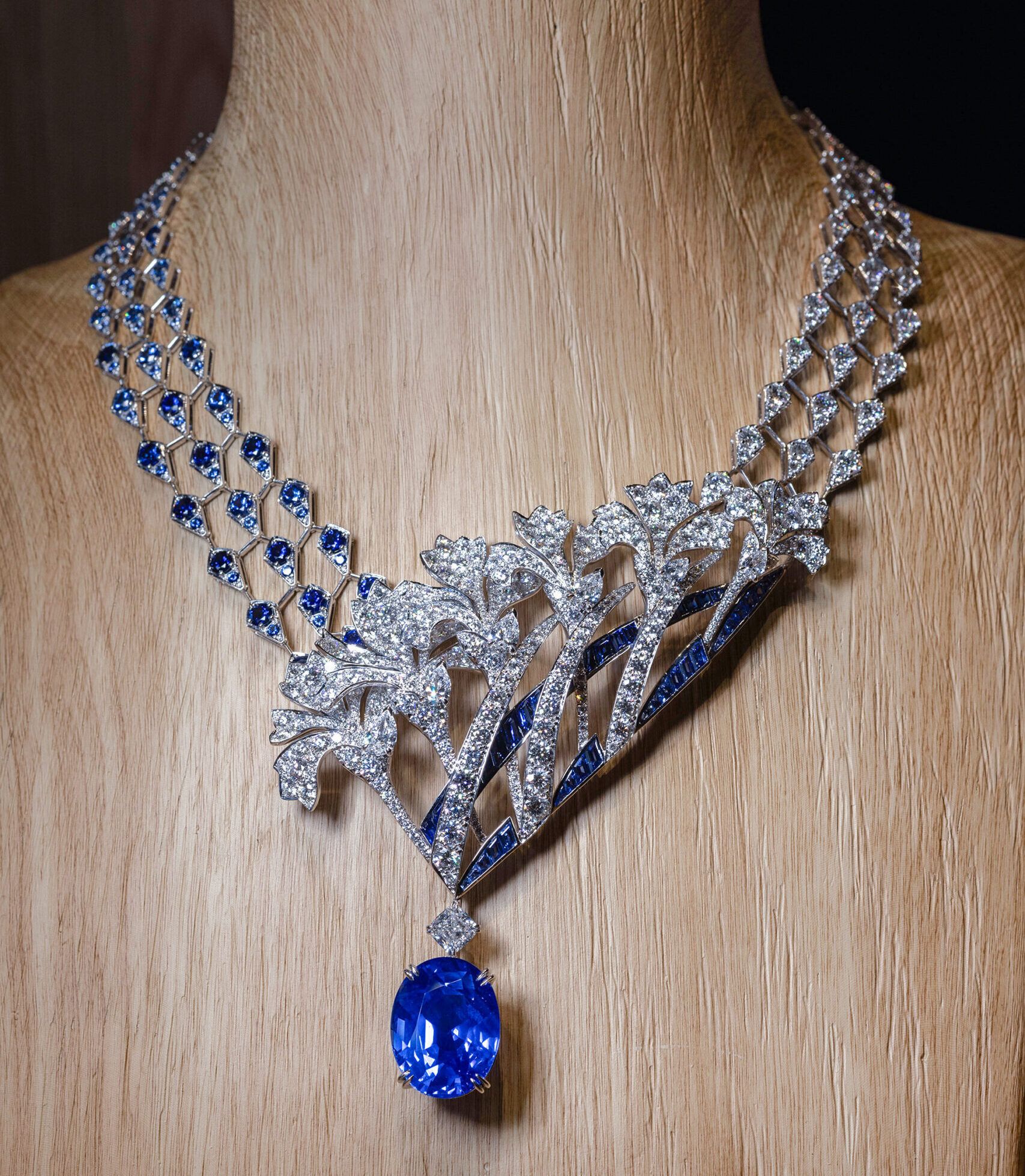
Stylising a famously ruffled bloom, six diamond-set flowers blossom in radiant asymmetry on the Carnation high jewellery necklace
Playing with volume, the Sword-Lily high jewellery parure is ablaze with rubies and light. Freed from their stems, three sword-lilies are positioned side by side on the necklace, their curved diamond petals overlaying a lattice of vines. Crafted using the fil couteau technique, the metal setting all but disappears, allowing seven Mozambique rubies to appear suspended in the air. The matching secret watch conceals time beneath a ruby and diamond sword-lily flower. When opened, a rich, translucent red dial is revealed, crafted in grand feu enamel by master enameller Anita Porchet, with the radiating hand-guilloché pattern bringing depth and motion to the watch face.
Three blooms are positioned side by side on the Sword-Lily necklace, their curved diamond petals overlaying a lattice of vines
The final Awakening suite captures the generosity of form of one of nature’s most fragrant blooms: the Sweetshrub. Voluminous white gold petals, set with pink sapphires and diamonds, embrace a 44.24 carat cushion cut pink spinel in the necklace. Presented on a strand of large, soft pink natural freshwater pearls, this three-dimensional centrepiece detaches to become a brooch. Continuing the sculptural theme, the Sweetshrub ring cradles a 20.04-carat rubellite in a swirl of lush, curled petals.
Chapter 3: Reviving
The blooms featured in the third and final chapter, Reviving, weren’t chosen at random—they’re flowers that grew in Joséphine’s famed greenhouse at Château de Malmaison or appeared in the botanical illustrations she commissioned to document her garden. One of the first exotic species Empress Joséphine cultivated at Malmaison, the magnolia became a symbol of her sophisticated taste and her influence in popularising the flower in France.
With removable white gold wires, the Magnolia Grandiflora high jewellery ear cuffs play with asymmetry
Portraying the magnolia’s full lifecycle, from sculpted leaf to flowering bloom, the Magnolia suite shifts between softness and structure. A brooch shaped like a single leaf sparkles with more than 8 carats of diamonds set in white gold, while another showcases a full flower, its broad, fleshy petals enhanced by snow-set diamonds.
A more pared-back expression appears in the Magnolia Grandiflora necklace, which took nearly 1,150 hours to complete. A minimalist bloom punctuates the neckline, with a remarkable 5.26-carat D Flawless type II pear shape diamond suspended beneath. The motif also blooms across a contemporary tiara, designed to be worn off-centre, like a bandeau. The magnolia here unfurls around a 2.02 carat pear shape diamond, with its petals pavé set both inside and out. Throughout, there’s a sense these are real flowers, not fixed or staged, but living.
The Dahlia parure explores the flower’s dynamic, spiralling form through a Chaumet speciality: transformability. At its heart is a tiara adorned with five detachable diamond rosettes. The concept draws inspiration from an archival tiara by Jean-Baptiste Fossin, created in the 1850s, which featured pansy blooms that could be removed and worn as individual jewels. In this contemporary interpretation, each diamond dahlia can be worn in a variety of ways—as brooches, hair ornaments or attached to a simple diamond rivière necklace.
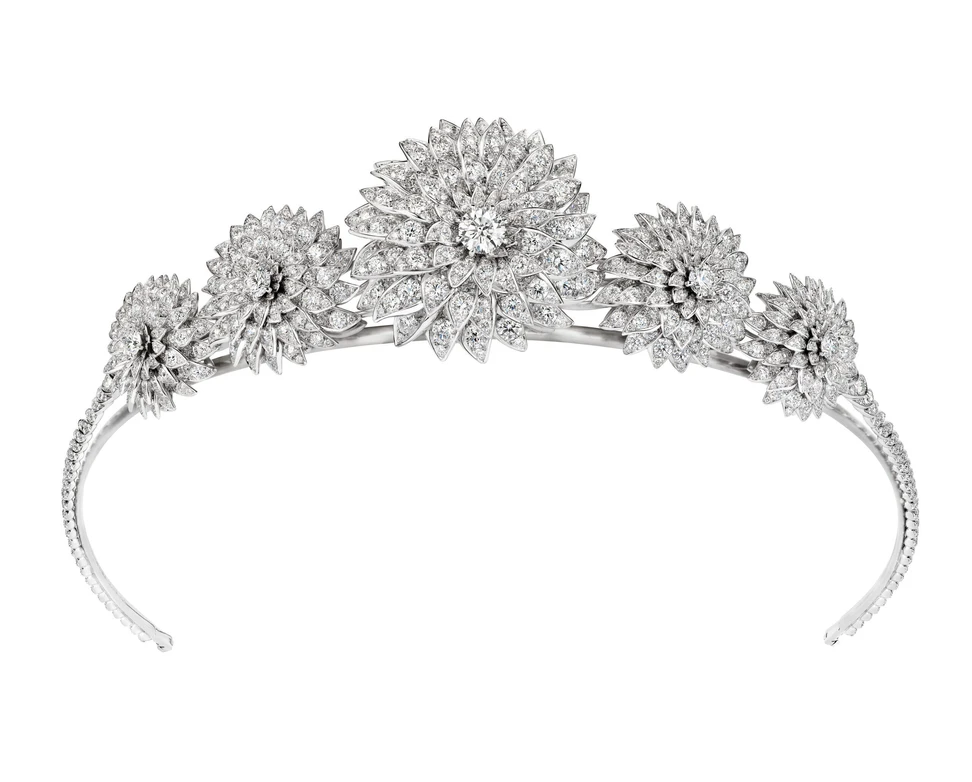
The Dahlia high jewellery tiara is adorned with five detachable diamond rosettes
Where the Dahlia parure is exuberant, the Water Lily suite is contemplative. Joséphine’s pond at Malmaison was home to these majestic aquatic blooms, with Chaumet capturing their delicate beauty in jewels that play with colour, light and transformation. At the centre of the necklace hangs a 23.11 carat pear-shaped imperial topaz, positioned below two blooming water lilies. Between the profusion of openwork diamond petals, a 4.51 carat pink spinel and a 6.12 carat violet spinel are set.
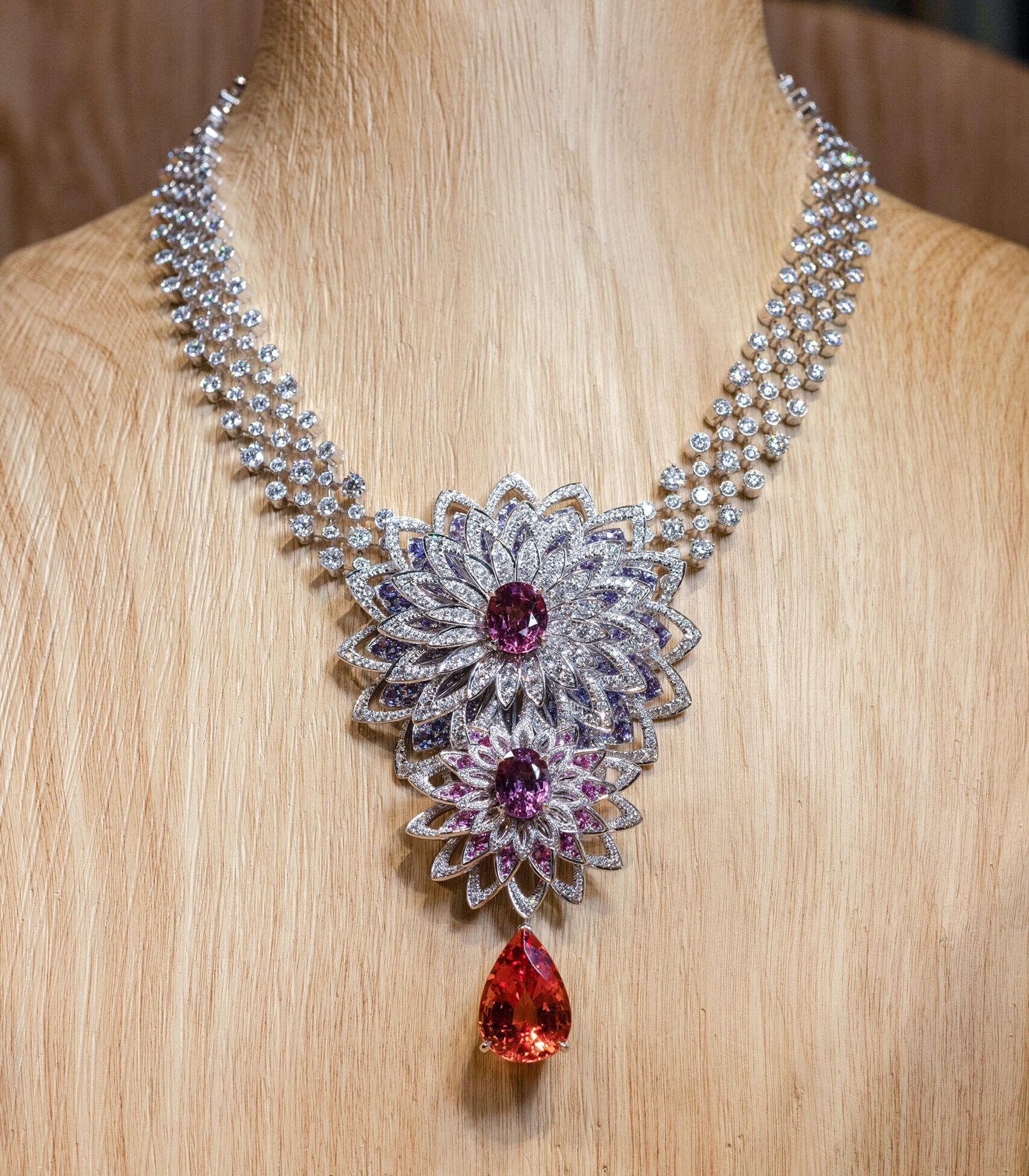
The Water Lily high jewellery necklace plays with colour and light. Between the profusion of openwork diamond petals, a 4.51 carat pink spinel and 6.12 carat violet spinel are set, paired with a 23.11 carat pear-shaped imperial topaz drop
Bringing the chapter to a close, Fairy Iris draws directly from Joséphine’s love of botanical illustration. The iris was among her most treasured flowers and frequently appeared in the watercolours of her official painter, Pierre-Joseph Redouté. Known for its vibrant violet markings, Chaumet’s interpretation is both exquisite and striking in how true to nature it is, with the flower’s soft, painterly palette reflected in the custom-cut Vietnamese spinels in lilac, blush pink and sky blue.
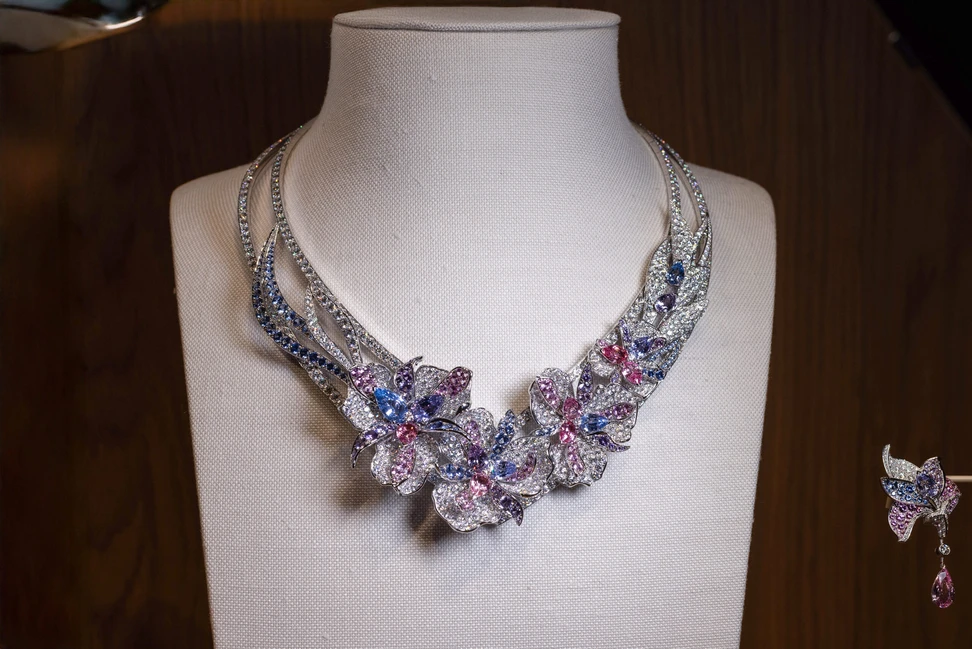
The Fairy Iris high jewellery necklace employs a painterly palette of Vietnamese spinels in lilac, blush pink and sky blue
Flitting Through the Pages: A Garden in Motion
No garden exists in stillness. As Joséphine knew, it is the flutter of wings and the soft hum of pollinators that bring it to life. In a nod to the creatures that once animated Malmaison’s glasshouses and trellised walkways, Chaumet has introduced jewelled insects and birds into the narrative of Jewels by Nature. A delicate ecosystem unfolds across all three chapters, from dragonflies flitting through oat fields and butterflies dancing between sword-lilies to birds gliding beneath blossoms.
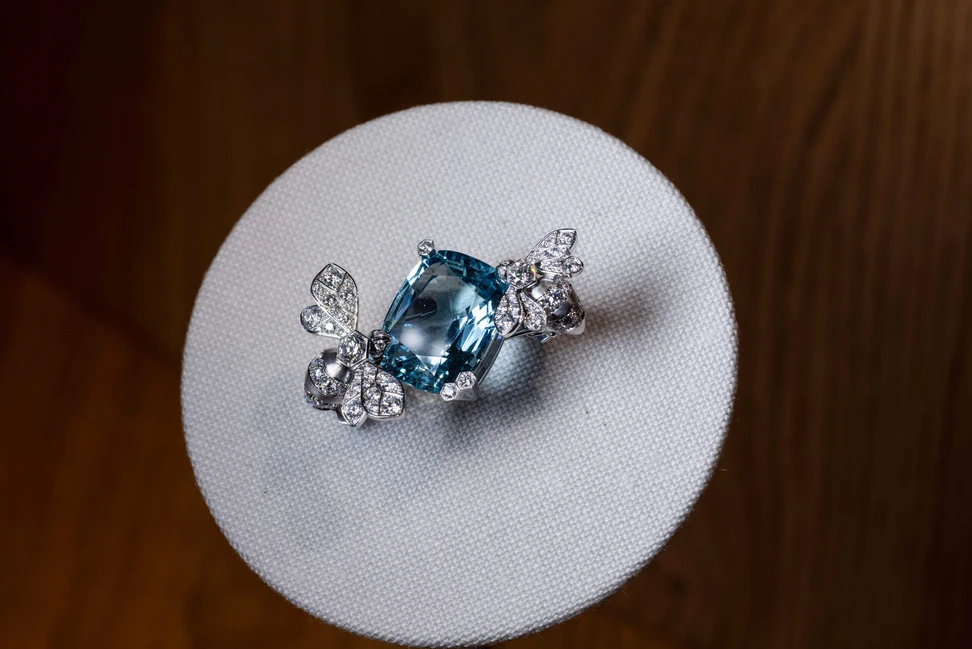
The bee takes centre stage in the collection’s finale in a series of seven high jewellery brooches, including this aquamarine and diamond version
Among these miniature marvels, it is the bee that takes centre stage in the collection’s finale. Inextricably linked to the history of the Maison since Napoléon I adopted it as a symbol of imperial power, the bee is also nature’s most vital pollinator. In Jewels by Nature, it flits from flower to flower, gathering vibrant stones as nectar.
Diamond bees buzz across seven high jewellery brooches, attracted by the vibrancy of a vivid cushion- or oval-cut gem—from aquamarine and rubellite to tourmaline and sapphire—held by honeycomb-inspired claws. Whimsical high jewellery interpretations of a Chaumet icon, these charming bee brooches complete Chaumet’s vision of a garden forever in bloom.
Just as spring breathes life into dormant gardens, Jewels by Nature signals a revival of Chaumet’s historic bond with the natural world. Intertwined with Empress Joséphine’s botanical legacy, the collection reawakens the Maison’s most poetic codes through fresh eyes and flourishing forms.

WORDS
Claire Roberts has been writing about jewellery and watches for more than 20 years. She is a seasoned journalist who joined the team 5 years ago as a contributing writer and a newsletter editor.
